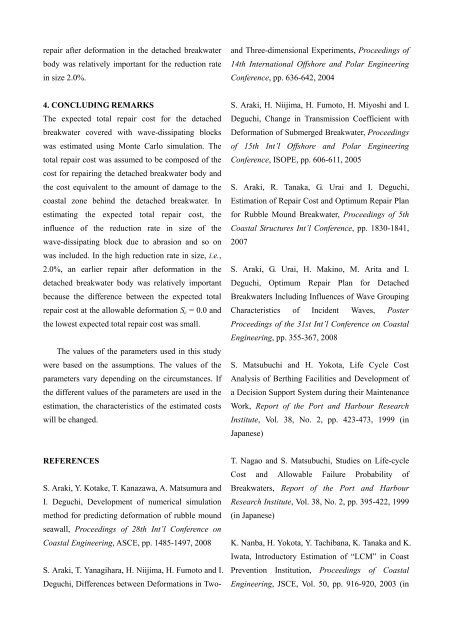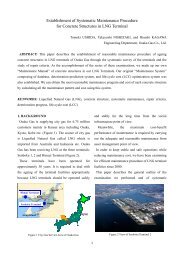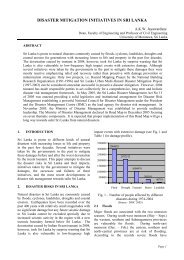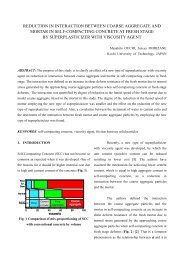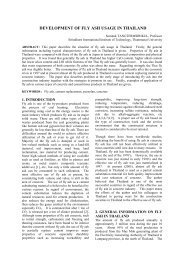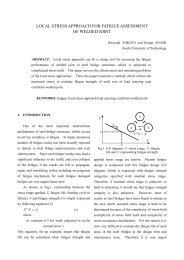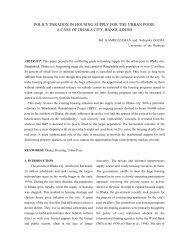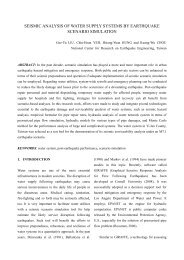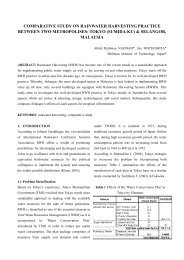estimation of expected repair cost for detached breakwater
estimation of expected repair cost for detached breakwater
estimation of expected repair cost for detached breakwater
Create successful ePaper yourself
Turn your PDF publications into a flip-book with our unique Google optimized e-Paper software.
epair after de<strong>for</strong>mation in the <strong>detached</strong> <strong>breakwater</strong><br />
body was relatively important <strong>for</strong> the reduction rate<br />
in size 2.0%.<br />
and Three-dimensional Experiments, Proceedings <strong>of</strong><br />
14th International Offshore and Polar Engineering<br />
Conference, pp. 636-642, 2004<br />
4. CONCLUDING REMARKS<br />
The <strong>expected</strong> total <strong>repair</strong> <strong>cost</strong> <strong>for</strong> the <strong>detached</strong><br />
<strong>breakwater</strong> covered with wave-dissipating blocks<br />
was estimated using Monte Carlo simulation. The<br />
total <strong>repair</strong> <strong>cost</strong> was assumed to be composed <strong>of</strong> the<br />
<strong>cost</strong> <strong>for</strong> <strong>repair</strong>ing the <strong>detached</strong> <strong>breakwater</strong> body and<br />
the <strong>cost</strong> equivalent to the amount <strong>of</strong> damage to the<br />
coastal zone behind the <strong>detached</strong> <strong>breakwater</strong>. In<br />
estimating the <strong>expected</strong> total <strong>repair</strong> <strong>cost</strong>, the<br />
influence <strong>of</strong> the reduction rate in size <strong>of</strong> the<br />
wave-dissipating block due to abrasion and so on<br />
was included. In the high reduction rate in size, i.e.,<br />
2.0%, an earlier <strong>repair</strong> after de<strong>for</strong>mation in the<br />
<strong>detached</strong> <strong>breakwater</strong> body was relatively important<br />
because the difference between the <strong>expected</strong> total<br />
<strong>repair</strong> <strong>cost</strong> at the allowable de<strong>for</strong>mation S c = 0.0 and<br />
the lowest <strong>expected</strong> total <strong>repair</strong> <strong>cost</strong> was small.<br />
The values <strong>of</strong> the parameters used in this study<br />
were based on the assumptions. The values <strong>of</strong> the<br />
parameters vary depending on the circumstances. If<br />
the different values <strong>of</strong> the parameters are used in the<br />
<strong>estimation</strong>, the characteristics <strong>of</strong> the estimated <strong>cost</strong>s<br />
will be changed.<br />
S. Araki, H. Niijima, H. Fumoto, H. Miyoshi and I.<br />
Deguchi, Change in Transmission Coefficient with<br />
De<strong>for</strong>mation <strong>of</strong> Submerged Breakwater, Proceedings<br />
<strong>of</strong> 15th Int’l Offshore and Polar Engineering<br />
Conference, ISOPE, pp. 606-611, 2005<br />
S. Araki, R. Tanaka, G. Urai and I. Deguchi,<br />
Estimation <strong>of</strong> Repair Cost and Optimum Repair Plan<br />
<strong>for</strong> Rubble Mound Breakwater, Proceedings <strong>of</strong> 5th<br />
Coastal Structures Int’l Conference, pp. 1830-1841,<br />
2007<br />
S. Araki, G. Urai, H. Makino, M. Arita and I.<br />
Deguchi, Optimum Repair Plan <strong>for</strong> Detached<br />
Breakwaters Including Influences <strong>of</strong> Wave Grouping<br />
Characteristics <strong>of</strong> Incident Waves, Poster<br />
Proceedings <strong>of</strong> the 31st Int’l Conference on Coastal<br />
Engineering, pp. 355-367, 2008<br />
S. Matsubuchi and H. Yokota, Life Cycle Cost<br />
Analysis <strong>of</strong> Berthing Facilities and Development <strong>of</strong><br />
a Decision Support System during their Maintenance<br />
Work, Report <strong>of</strong> the Port and Harbour Research<br />
Institute, Vol. 38, No. 2, pp. 423-473, 1999 (in<br />
Japanese)<br />
REFERENCES<br />
S. Araki, Y. Kotake, T. Kanazawa, A. Matsumura and<br />
I. Deguchi, Development <strong>of</strong> numerical simulation<br />
method <strong>for</strong> predicting de<strong>for</strong>mation <strong>of</strong> rubble mound<br />
seawall, Proceedings <strong>of</strong> 28th Int’l Conference on<br />
Coastal Engineering, ASCE, pp. 1485-1497, 2008<br />
S. Araki, T. Yanagihara, H. Niijima, H. Fumoto and I.<br />
Deguchi, Differences between De<strong>for</strong>mations in Two-<br />
T. Nagao and S. Matsubuchi, Studies on Life-cycle<br />
Cost and Allowable Failure Probability <strong>of</strong><br />
Breakwaters, Report <strong>of</strong> the Port and Harbour<br />
Research Institute, Vol. 38, No. 2, pp. 395-422, 1999<br />
(in Japanese)<br />
K. Nanba, H. Yokota, Y. Tachibana, K. Tanaka and K.<br />
Iwata, Introductory Estimation <strong>of</strong> “LCM” in Coast<br />
Prevention Institution, Proceedings <strong>of</strong> Coastal<br />
Engineering, JSCE, Vol. 50, pp. 916-920, 2003 (in


